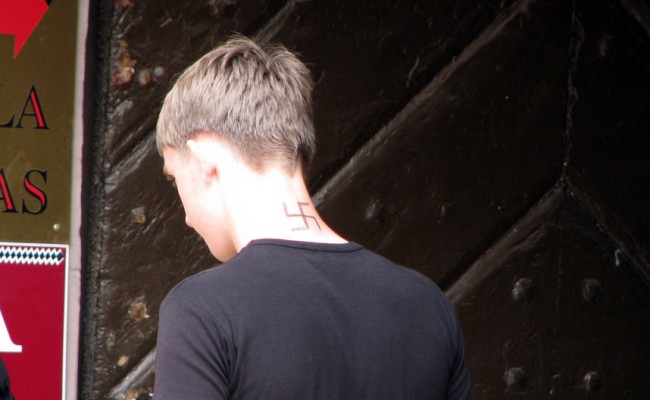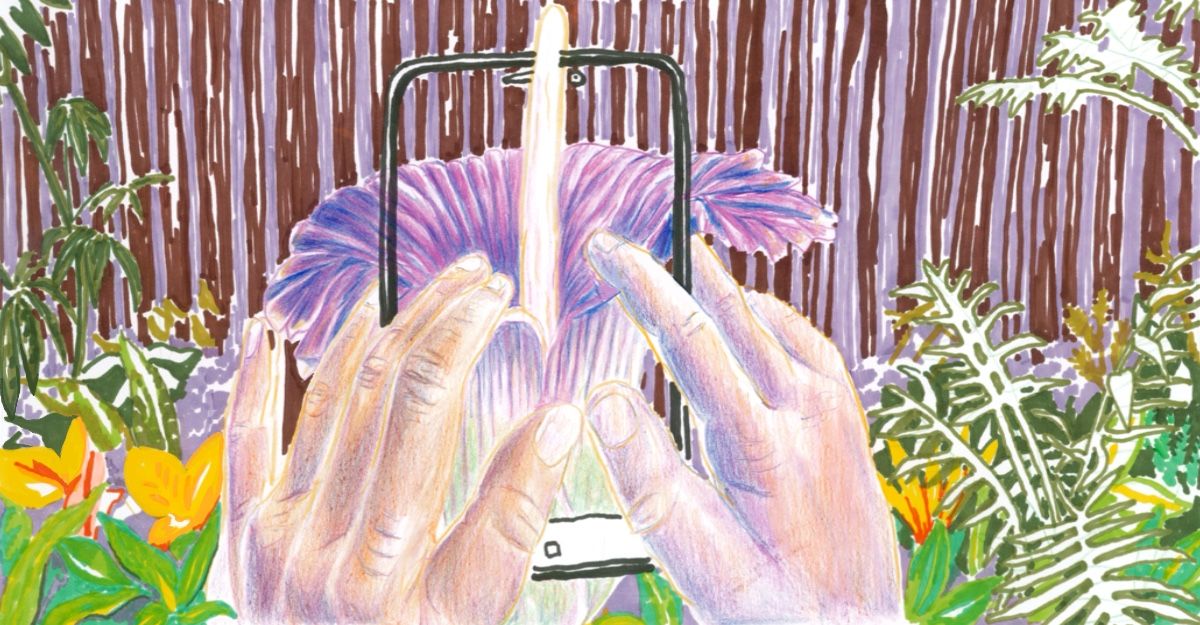Last month, following a campaign of racist threats, a Melbourne advertiser removed an Australia Day billboard featuring two hijab-wearing children. Crucially, according to the ABC, the abuse didn’t originate spontaneously from garden-variety bigots. It was directed, at least in part, by the United Patriots Front.
Overland readers will know the UPF as a tiny fascist groupuscle led by Blair Cottrell: a convicted criminal and National Socialist who wants pictures of Adolf Hitler installed in every school. How did his handful of Nazis manage to bring down the Australia Day advertisement?
The answer lies in the UPF’s surprisingly large social media presence, a presence that gives the group an online influence out of all proportion to its real size. Some twenty thousand people shared the original UPF post about the Australia Day billboard, sufficient to make the hijab-wearing children a target for mainstream rightwing populists.
That trajectory — a ginned-up scandal propelling the fringes to the centre — is not anomalous. The UPF page boasts in excess of a hundred thousand likes, which guarantees its content a substantial readership. A clip in which Cottrell whines about his legal travails has been shared a stunning 600,000 times; another in which he blames Islam for the recent tragedy in Melbourne’s Bourke Street received 75,000 views and 1800 likes.
In other words, the UPF’s Facebook page constitutes the group’s biggest asset, in ways that we need to consider.
Would-be dictators have long been tormented by the distinctive organisational problems facing fascists in Australia. In a colonial settler state unified on the basis of the White Australia policy, a small but not insignificant constituency has always existed for the racial hokum and conspiracy-mongering of the Far Right, an audience that’s almost certainly expanded in a period of widespread disaffection from mainstream politics.
The difficulty for would-be Hitlers lies in the atomisation of their potential base. A political star like Pauline Hanson can draw votes from the downwardly mobile petit bourgeois (struggling contractors, shop owners like Hanson, etc) of rural Queensland, the demoralised and declassed workers on the fringes of the major cities and the out-and-out lumpens (bikers, skinheads, criminals, etc). But how does a fringe fascist group contact isolated people separated by thousands of kilometres? Even if it does reach them, how does it cohere individuals with nothing in common other than their anger and alienation? How do you build a movement out of human dust?
The League of Rights — the great granddaddy of the Australian Far Right — long ago set out to service rural anti-Semites with its mailed bulletins and leaflets. Its model was a version of Lenin’s notion about a newspaper providing, in a geographically vast country, the scaffolding of a political organisation. But Lenin envisaged a party built out of a class-based collectivity to which a fascist group like the League couldn’t appeal. More importantly, the League’s membership remained largely passive. Subscribing to a far-right paper didn’t necessarily demand any more from readers than buying a mainstream paper: it wasn’t, in and of itself, likely to turn a small town bigot into the fighting cadre a fascist outfit required.
In the long-term, fascism depends on controlling the streets. Fascists distinguish themselves from the traditional Right by the violence they direct against unions, minorities and popular organisations. A fascist leader unifies his motley supporters by the spectacular aggression unleashed against enemies: regular brutality rather than any particular doctrine holds the group together
That’s why the more aggressive and ambitious far-right groups have always tried to organise public events in the big cities. Even a small rally bonds together the disparate and scattered supporters of a fringe group in a way that a newspaper simply doesn’t. Hence the efforts by the UPF to bus the flotsam and jetsam of the Far Right into set-piece demonstrations in Melbourne and elsewhere.
Of course, such mobilisations provide an obvious target for counter-demonstrators entirely conversant with the historical role that rallies have played in fascism’s rise. Given the Left’s comparative strength in the cities, an attempt by the Far Right to organise centrally will almost certainly be met with a much larger anti-racist protest.
Yet the Left’s success in blocking fascist marches should not blind us to the extent to which social media offers the Far Right a new method of growth.
Most obviously, a Facebook page provides an easy alternative to the hoary newsletters on which the League of Rights relied. Unlike the expensive and time-consuming process of publishing a paper, Facebook is free and simple: an everyday part of ordinary people’s lives, even in the bush.
Furthermore, Facebook rests an interactivity that print lacks. Where someone on a mailing list remains passive, social media allows enthusiasts to engage with each new post as it appears, debating with the author and with other readers in the comment threads before sharing the content further. Facebook encourages users to argue, to annotate and to proselytise: it provides, in other words, many of the functions of the traditional political meeting, which is why it’s far more effective than print in turning consumers into activists.
Obviously, this should not be overstated. The social bonds produced by social media are weak compared to those forged in real-life engagements. A Facebook discussion might replicate a meeting but only to a limited and partial degree.
Nevertheless, the Left shouldn’t allow the (largely dismal) experience of online progressive activism to obscure the utility of Facebook for fascists, especially since a case could be made that social media in general — and Facebook in particular — offers much more to the Right than to the Left.
Think of the notorious ‘social media bubble’ effect — the mechanism by which Facebook deluges users with content similar to that which they’ve already consumed. It’s an outcome disastrous for a democratic movement engaging with the world, rendering activists out of touch with the reality they seek to change. But for that very reason it serves the Far Right nicely: the algorithms providing articles confirming your prejudices works very nicely for a political current based on conspiracy-mongering, creating a parallel universe in which everyone agrees that, for instance, Islamic State organised the Bourke Street murders.
One might go so far as to suggest that Facebook’s structurally suited to the peculiarities of fascist organising. On the one hand, a group’s page invites all its readers to add their two cents, offering, in that way, a kind of collectivity. On the other hand, that participation’s not in any respect democratic, since the owner shapes and controls the experiences of the users. What we might call Facebook’s authoritarian collectivism suits the fascist personality neatly: with each post, an unelected leader makes a pronouncement, which his followers are expected to hail loudly and enthusiastically via the like button.
In that respect, the platform itself accustomises readers to the distinctive organisational forms of the Far Right. Attempts to establish fascist parties in Australia generally collapse into recriminations quite quickly, partly because even enthusiastic Rightists find the fuehrer principle hard to swallow (at least, when they’re not fuehrer themselves). On Facebook, however, the dictatorial control exercised by the page owner is built into the service.
To put it another way, Facebook means the UPF doesn’t really need a traditional party structure, at least in the short term. Why establish formal memberships, meetings, conferences and other such wearisome encumbrances when the small handful of people in charge of the social media passwords can issue statements, direct campaigns and even raise money by tapping on a keyboard?
Yes, if the UPF is to build a serious fascist presence in Australia, it will eventually need to prioritise the creation of a street movement. But there’s no reason why that should be an immediate task. The relative social stability in the country at the moment means that an orientation to public brawling right now would probably engender substantial pushback by the state. We’re not currently facing the kind of social crisis that might spur elements of the establishment to look favourably on a rightist group smashing up demonstrations or breaking picket lines.
That’s why, for the time being, Facebook provides the ideal forum for the UPF and similar groups: a platform from which they can reach audiences that would have been unimaginable for fascist organisers two decades ago, thus popularising (at a fairly low level) key themes of the Far Right.
The incident around the Australia Day billboard offers a good illustration.
That’s why, alongside the effort to counter UPF rallies, we need a determined and broadly backed social media campaign to block the fascists online.
There have long been individuals and small groups trolling the Far Right, often with some success. But we need to go beyond that, to adopt a systematic approach to isolating and exposing the UPF’s real nature.
In isolation, the UPF’s material doesn’t necessarily seem different to posts from One Nation or even the fringe elements of the Coalition. As a classical National Socialist, Cottrell’s preoccupied with the so-called ‘Jewish threat’. But he’s decided to downplay his anti-Semitism (and his enthusiasm for Hitler) to pursue the more political palatable theme of Islamophobia — and, as a result, the more widely distributed UPF clips are circulated by people unfamiliar with the organisation’s National Socialism.
A concerted effort to popularise Cottrell’s record of violence and personal devotion to Hitlerism might force other groups on the Right to distance themselves from the UPF online, as well as providing a counter-resource to re-orient those who stumble on the UPF accidentally. In particular, we should document and expose the regularity with which the UPF page contains threats of violence. It is, after all, rare to reach the end of a UPF comments thread without encountering manifold calls for someone to be bashed, shot, raped or murdered.
And let’s not forget the recent arrest of UPF supporter Phillip Galea on charges of plotting to bomb the headquarters of the Socialist Alliance. We need to publicise the UPF’s history sufficiently well that anyone who encounters the group on social media will quickly become aware of its true nature.
A concerted social media strategy highlighting the UPF’s violence might spur Facebook to delete its account (the company claims not to tolerate hate groups using the service). But we can’t rely on such an outcome, which is why it makes sense to orient a campaign to ordinary users rather than moderators.
Let’s not forget that the UPF’s reliance on Facebook makes the group intensely vulnerable. Without its social media reach, it’s got nothing: no membership lists, no publications, no profile.
The billboard incident is trivial in and of itself. It should, however, serve as a wake up call. The Nazis are building online and it’s well past time to stop them.
Image: ‘Fascist’ / Leszek Kozlowski







